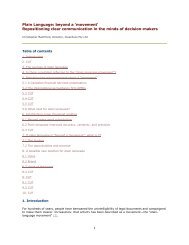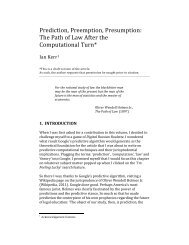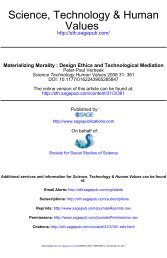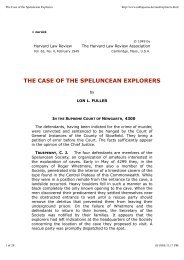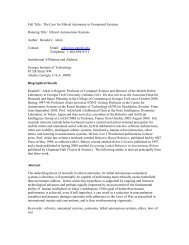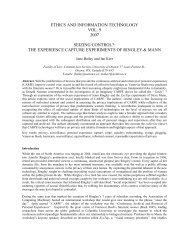'Asimov's Laws of Robotics' - the Laws of Robotics 2013
'Asimov's Laws of Robotics' - the Laws of Robotics 2013
'Asimov's Laws of Robotics' - the Laws of Robotics 2013
- No tags were found...
You also want an ePaper? Increase the reach of your titles
YUMPU automatically turns print PDFs into web optimized ePapers that Google loves.
Roger Clarke's <strong>'Asimov's</strong> <strong>Laws</strong> <strong>of</strong> <strong><strong>Robotics</strong>'</strong><strong>2013</strong>-09-03 10:33 AMWith <strong>the</strong>ir fictional "positronic" brains imprinted with <strong>the</strong> mandate to (in order <strong>of</strong> priority) prevent harm tohumans, obey <strong>the</strong>ir human masters, and protect <strong>the</strong>mselves, Asimov's robots had to deal with greatcomplexity. In a given situation, a robot might be unable to satisfy <strong>the</strong> demands <strong>of</strong> two equally powerfulmandates and go into "mental freezeout." Semantics is also a problem. As demonstrated in Part 1 <strong>of</strong> thisarticle (Computer, December 1993, pp. 53- 61), language is much more than a set <strong>of</strong> literal meanings andAsimov showed us that a machine trying to distinguish, for example, who or what is human may encountermany difficulties that humans <strong>the</strong>mselves handle easily and intuitively. Thus, robots must have sufficientcapabilities for judgment - capabilities that can cause <strong>the</strong>m to frustrate <strong>the</strong> intentions <strong>of</strong> <strong>the</strong>ir masters when, ina robot's judgment, a higher order law applies.As information technology evolves and machines begin to design and build o<strong>the</strong>r machines, <strong>the</strong> issue <strong>of</strong>human control gains greater significance. In time. human values tend to change; <strong>the</strong> rules reflecting <strong>the</strong>sevalues, and embedded in existing robotic devices. may need to be modified. But if <strong>the</strong>y are implicit ra<strong>the</strong>rthan explicit, with <strong>the</strong>ir effects scattered widely across a system, <strong>the</strong>y may not be easily replaceable. Asimovhimself discovered many contradictions and eventually revised <strong>the</strong> <strong>Laws</strong> <strong>of</strong> <strong>Robotics</strong>.Asimov's 1985 revised <strong>Laws</strong> <strong>of</strong> <strong>Robotics</strong>The Zeroth lawAfter introducing <strong>the</strong> original three laws, Asimov detected. as early as 1950, a need to extend <strong>the</strong> first law,which protected individual humans, so that it would protect humanity as a whole. Thus, his calculatingmachines "have <strong>the</strong> good <strong>of</strong> humanity at heart through <strong>the</strong> overwhelming force <strong>of</strong> <strong>the</strong> First Law <strong>of</strong> <strong>Robotics</strong>" 1(emphasis added). In 1985 he developed this idea fur<strong>the</strong>r by postulating a "zeroth" law that placed humanity'sinterests above those <strong>of</strong> any individual while retaining a high value on individual human life. 2 The revised set<strong>of</strong> laws is shown in <strong>the</strong> sidebar.Asimov pointed out that under a strict interpretation <strong>of</strong> <strong>the</strong> first law, a robot would protect a person even if<strong>the</strong> survival <strong>of</strong> humanity as a whole was placed at risk. Possible threats include annihilation by an alien ormutant human race, or by a deadly virus. Even when a robot's own powers <strong>of</strong> reasoning led it to conclude thatmankind as a whole was doomed if it refused to act, it was never<strong>the</strong>less constrained: "I sense <strong>the</strong> oncoming <strong>of</strong>catastrophe . . . [but} I can only follow <strong>the</strong> <strong>Laws</strong>." 2In Asimov's fiction <strong>the</strong> robots are tested by circumstances and must seriously consider whe<strong>the</strong>r <strong>the</strong>y can harma human to save humanity. The turning point comes when <strong>the</strong> robots appreciate that <strong>the</strong> laws are indirectlymodifiable by roboticists through <strong>the</strong> definitions programmed into each robot: "If <strong>the</strong> <strong>Laws</strong> <strong>of</strong> <strong>Robotics</strong>, even<strong>the</strong> First Law, are not absolutes, and if human beings can modify <strong>the</strong>m, might it not be that perhaps, underproper conditions, we ourselves might mod - " 2 Although <strong>the</strong> robots are prevented by imminent "roblock"(robot block, or deadlock) from even completing <strong>the</strong> sentence, <strong>the</strong> groundwork has been laid.Later, when a robot perceives a clear and urgent threat to mankind, it concludes, "Humanity as a whole ismore important than a single human being. There is a law that is greater than <strong>the</strong> First Law: `A robot may notinjure humanity, or through inaction, allow humanity to come to harm." 2Defining "humanity"http://www.rogerclarke.com/SOS/Asimov.htmlPage 14 <strong>of</strong> 30



